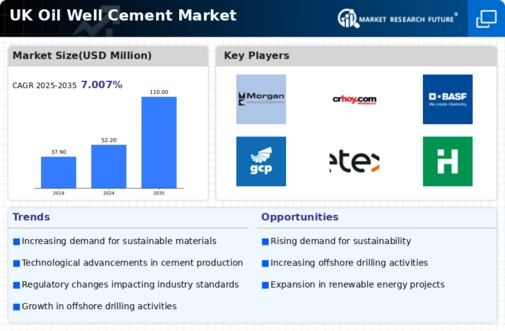Rising Demand for Energy
The oil well-cement market is experiencing a notable increase in demand driven by the UK's growing energy needs. As the country seeks to enhance its energy security, the exploration and production of oil and gas are likely to intensify. This trend is reflected in the UK government's commitment to increasing domestic energy production, which could lead to a projected growth of 4% in the oil well-cement market by 2027. The need for reliable cementing solutions in drilling operations is paramount, as it ensures the integrity of wellbore structures. Consequently, the oil well-cement market is poised to benefit from this rising demand, as operators require high-quality cement products to support their drilling activities.
Technological Innovations in Cementing
Technological innovations are reshaping the oil well-cement market, as advancements in cement formulations and application techniques enhance performance. The introduction of smart cement technologies, which can monitor well conditions in real-time, is gaining traction in the UK. These innovations not only improve the efficiency of cementing operations but also reduce the risk of well failures. The oil well-cement market is likely to see increased adoption of these technologies, as operators seek to optimize their drilling processes. Furthermore, the integration of automation and data analytics in cementing operations could lead to cost savings and improved safety, making it a pivotal driver for market growth.
Environmental Regulations and Standards
The oil well-cement market is influenced by stringent environmental regulations and standards imposed by the UK government. These regulations aim to minimize the environmental impact of oil and gas operations, necessitating the use of eco-friendly cement products. As a result, companies in the oil well-cement market are increasingly focusing on developing sustainable cement solutions that comply with these regulations. The market could witness a shift towards low-carbon cement alternatives, which may account for up to 30% of the total cement used in oil well applications by 2030. This trend not only aligns with the UK's environmental goals but also presents opportunities for innovation within the industry.
Investment in Oil and Gas Infrastructure
Investment in oil and gas infrastructure is a critical driver for the oil well-cement market. The UK government has announced plans to allocate £1 billion towards enhancing oil and gas facilities, which is expected to stimulate the market significantly. This investment is likely to lead to the construction of new drilling sites and the refurbishment of existing ones, thereby increasing the demand for oil well-cement. The oil well-cement market must adapt to these developments by providing innovative and efficient cementing solutions that meet the evolving needs of the sector. As infrastructure projects progress, the market could see a surge in orders for cement products, further solidifying its position in the energy landscape.
Growing Exploration Activities in Offshore Regions
The oil well-cement market is significantly impacted by the growing exploration activities in offshore regions of the UK. As companies seek to tap into untapped reserves, the demand for cementing solutions in offshore drilling operations is expected to rise. The UK Continental Shelf is witnessing renewed interest, with several new projects slated for development. This surge in exploration activities could lead to an estimated increase of 5% in the oil well-cement market by 2026. The oil well-cement market must prepare to meet this demand by ensuring the availability of high-performance cement products that can withstand the unique challenges posed by offshore environments.


























Leave a Comment